#Boeing 2707-300
Text

A former TWA Boeing 2707 SST in the boneyard.
Note: happy April fool's day
Date: April 1, 1998
source
#Boeing 2707-300#Boeing 2707#2707-300#2707#Supersonic Transport#SST#Supersonic Transport Project#National Supersonic Transport Program#NST#Supersonic Passenger Airliner#Cancelled#boneyard#TWA#1998#april fool's day#april fool's#April#my post
42 notes
·
View notes
Text

An artist’s conceptual illustration of the Boeing 2707-300 super sonic transport.
#sst#vintage illustration#boeing#boeing sst#super sonic transport#the 60s#air travel#vintage air travel#jet airliners
28 notes
·
View notes
Text

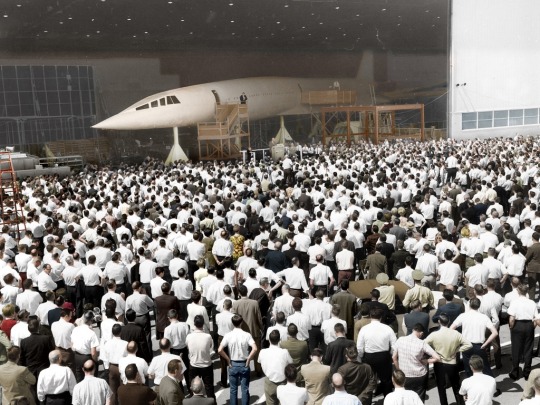
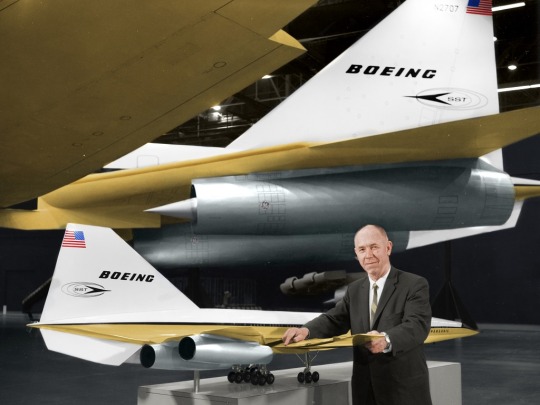

The Boeing 2707 was an American supersonic passenger airliner project during the 1960s. It was designed to carry 250 to 300 passengers with cruise speeds of approximately Mach 3. Rising costs and the lack of a clear market led to its cancellation in 1971 before two prototypes had been completed.
3 notes
·
View notes
Text
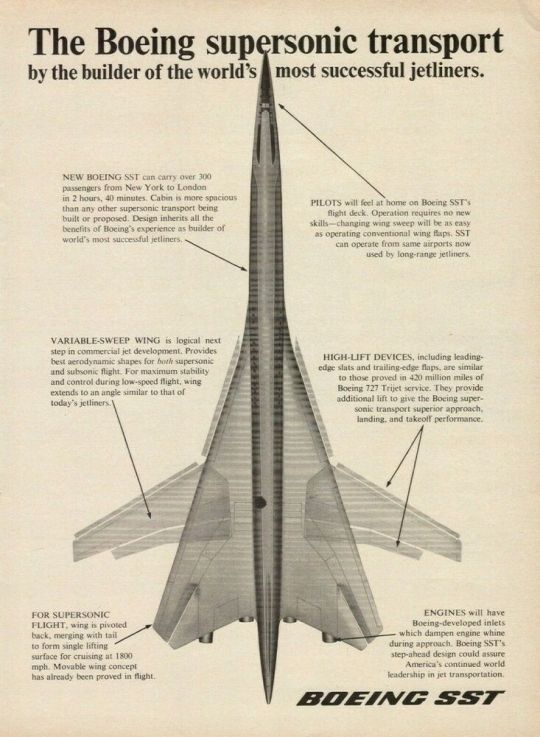

The Boeing 2707 was an American supersonic passenger airliner project during the 1960s. After winning a competition for a government-funded contract to build an American supersonic airliner, Boeing began development at its facilities in Seattle, Washington. The design emerged as a large aircraft with seating for 250 to 300 passengers and cruise speeds of approximately Mach 3. It was intended to be much larger and faster than competing supersonic transport (SST) designs such as Concorde.
The SST was the topic of considerable concern within and outside the aviation industry. From the start, the airline industry noted that the economics of the design were questionable, concerns that were only partially addressed during development. Outside the field, the entire SST concept was the subject of considerable negative press, centered on the issue of sonic booms and effects on the ozone layer.
A key design feature of the 2707 was its use of a swing wing configuration. During development, the required weight and size of this mechanism continued to grow, forcing the team to switch to a conventional delta wing. Rising costs and the lack of a clear market led to its cancellation in 1971 before two prototypes had been completed.
0 notes
Note
what's your fav history fact + fav sci fi media 👀
and the third q...least favourite Cars character? >:]
Hi! Thank you for these wonderful questions! I'll try my best to not write an entire essay.
Favorite History Fact
Oooh, this is a toughie. I don't think I can pick just one, so here are a few:
During World War I, steel shortages compelled the U.S. government to commission ocean-going ships made out of concrete. One of these, the SS Atlantus, was launched in 1918 and used to transport American servicemen home from Europe after the war's end. In 1926, it was brought to Cape May, New Jersey with the intention of using it as part of a ferry dock, but it unfortunately ran aground during a storm before these plans could come to fruition. After all attempts to get it unstuck failed, it just sat there off the coast, at one point being used as a billboard. It's still there, but these days only a tiny bit peeks above the water. I grew up around this area and remember being taken to see it as a kid.

A man named William Crothers Dulles sailed on the Titanic in First Class, and sadly died in the sinking. His body was recovered and buried in the family mausoleum in Laurel Hill Cemetery in Philadelphia. Dulles is something of an enigma because so little is known about him. He allegedly had a law degree from the University of Pennsylvania but 1) never practiced law and 2) the school had no record of his attendance. He owned a horse farm in New York, had a huge collection of sports memorabilia, and could afford to travel First Class, so he was clearly a man of means. But what was his deal? Did he lie about his legal qualifications, and if so, why? IDK, he was probably just a rich guy who didn't need to work, but his whole story is just a bit weird. Only a couple of people remembered seeing him on the ship, and (allegedly) no known photograph of him exists. I went on a tour of the cemetery and visited his mausoleum about a year ago and still think about this story from time to time.

The Boeing 2707 was America's answer to the British-French Concorde. This aircraft was designed to hold up to 300 passengers and travel at almost three times the speed of sound, leaving its competition in the dust. Unfortunately, this project proved too ambitious for a number of political and economic reasons, and its development was cancelled in the early 1970s. It's kind of a shame, because it was one cool-looking plane. I think it's interesting to look at what people in the past thought the future was going to be like. I also have a LM (though not Pixar Cars) character based on this aircraft.

Favorite Sci-Fi Media
If I need to pick one (and I will actually pick one this time), I need to go with the works of Ray Bradbury. I read The Martian Chronicles and The Illustrated Man in high school and both of them blew me away. They are older and, to be fair, are absolutely dated in places, but the author's writing style and imagination are still phenomenal. If you're looking for the "greatest hits," I recommend reading "There Will Come Soft Rains" from The Martian Chronicles and "The Veldt" from The Illustrated Man.


Least Favorite Cars Character
Honestly, I don't have a least-favorite. Even the ones who are jerks fall into the "love-to-hate" category for me. I'm mostly thinking about Chick Hicks here. As much of an ass as he is, I can't bring myself to hate the guy. He's just too much fun.

Thanks again for the ask!
#asks#answered#fraiserabbit#history#titanic#maritime history#ss atlantus#boeing 2707#aviation#science fiction#sci fi#Ray Bradbury#books#pixar cars#cars fandom#Chick Hicks
13 notes
·
View notes
Text
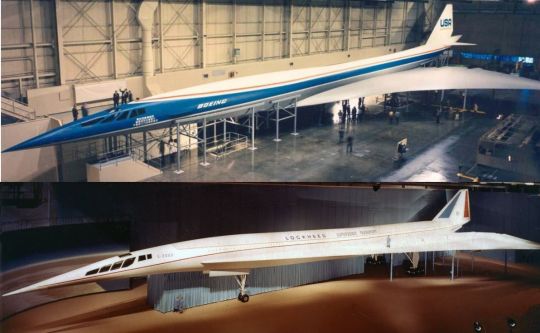
-Mockups of the two final American SST concepts, the Boeing 2707 and the Lockheed L-2000. | Composite Photo: Justin Gibb
FLIGHTLINE: 136 - AMERICAN SST PROGRAM
Various programs to develop a supersonic transport in the US stretched from the middle 1950s until the early 1970s, but no aircraft ever resulted.
The first recorded supersonic flight (the speed of sound is 767mph at 20°C/68°F at sea level) was on 14 October 1947, when the American X-1, piloted by Chuck Yeager, reached Mach 1.06. By the 1950s, supersonic flight became a more regular occurrence, though it was still almost exclusively restricted to military pilots. Around this time, various projects around the world began to develop airliners that could break the sound barrier too. Designs like the Sud Aviation Super-Caravelle and Bristol Type 223 were sketched, but technical limitations as well as a lack of funding stalled those efforts.
♫NINETY MINUTES FROM NEW YORK TO PARIS♫
Research continued however, and by the early-1960s a new round of programs were started, with BAC (later BAe and BAE Systems) and Sud Aviation (later Aérospatiale and Airbus) joining forces to produce what became Concorde, while the Soviet design bureau Tupolev developed the Tu-144 (NATO reporting name "Charger"). Numerous American carriers placed orders for Concorde aircraft, but spiraling costs and a desire to develop a domestic SST saw those orders canceled in the early 1970s. In the end, only Air France and BOAC/British Airways operated Concorde, while the Tu-144 was exclusively flown by the Soviet state airline Aeroflot.
BUY AMERICAN!
The FAA estimated in the early 1960s that there would be a market for 500+ SSTs by the year 1990. Fearing Anglo-French domination of the airline industry, the US Congress began funding various research programs, and President John F Kennedy announced a National Supersonic Transport program on 5 June 1963. Requests for proposals were sent to Boeing, Lockheed, and North American for the airframes; and Curtiss-Wright, General Electric and Pratt & Whitney for engines. The request stipulated a cruise speed of Mach 3, and a passenger capacity of up to 300. Preliminary designs were submitted on 15 January 1964
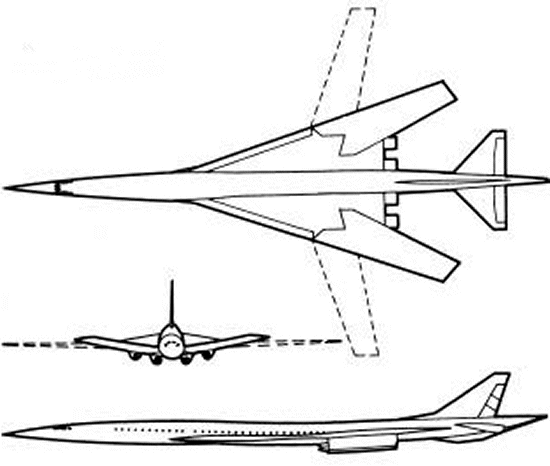
-Line drawing of the Boeing 733-790 SST, which initially featured swing wings. | Illustration: Boeing
The Boeing 733 model featured a large blended wing root with variable geometry outer panels, resembling an enlarged Rockwell B-1. The proposal included optional fuselage extensions, potentially increasing capacity to 227 passengers.

-Line drawing of the the CL-823. | Illustration: Lockheed Corp.
Lockheed's CL-823 was functionally an enlarged Concorde, though the wing shape was a cranked arrow rather than Concorde's ogival delta.
The North American NAC-60 was the smallest and slowest of the competitors, potentially transporting 187 passengers at Mach 2.65.
In 1965 the FAA downselected the NAC-60 design, as well as Curtiss-Wright's engine work, freeing up funds for Boeing and Lockheed on the airframe side and P&W and GE for the engine development.
TIME TO SHARPEN YOUR PENCIL.
The FAA scheduled a final selection in 1966, and requested detailed proposals from Boeing and Lockheed. Boeing had gone through several iterations of the Model 733, with the 733-390 being presented in September 1966. The aircraft was one of the first wide-body airliners, with 2-3-2 seating. In the 30-seat first class section, small tv's were to be integrated into a console between the seats, while in the 247-seat tourist class section larger retractable tv's would drop from the overheads every six rows. Externally, the engine pods had been moved back under the tail, and the wings, when swept back, would form a delta with the tail.
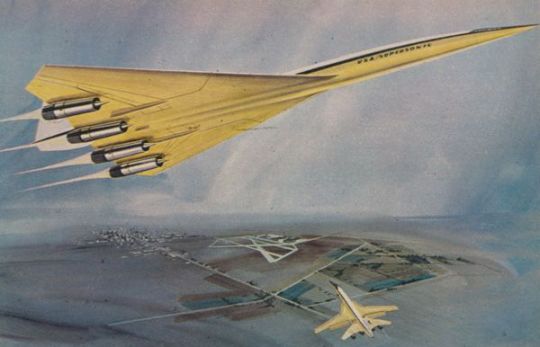
-Illustration of the 733-390, with one at maximum sweep and one at minimum. | Illustration: Boeing.
Lockheed's CL-823 had evolved as well, with the L-2000-1 design having changed from a cranked arrow to a delta wing, with the engines separated into individual pods. In order to speed production, the L-2000 was projected to use a derivative of the J58 engine that had powered the A-12 OXCART and SR-71 Blackbird. New requirements from the government saw changes to the wing and fuselage, and the engine pods were redesigned to accommodate either the P&W JTF-17A or GE4 designed as part of the SST program. The final design presented to the FAA was the L-2000-7A/B (the B was 20 feet longer), which had a passenger capacity of 230.

-Advertising image of the L-2000-7A. | Illustration: Monsigneurhulot
THE FINAL SHOWDOWN
The final designs, complete with full-scale mockups, were presented in September 1966.

-The full-scale mockup of the 733-390, in a striking white-over-yellow paint scheme. The size of the plane is evident from the man standing near the third jack. | Photo: Boeing

-Appearing no less impressive, the Lockheed L-2000 mockup. | Photo: Lockheed
FAA review of the competing SSTs took until December, with the Boeing design being announced the winner on 1 January 1967. The L-2000 was judged to easier to produce, but it was also thought to be less risky and advanced than the Boeing entry, and thus the latter was more in the spirit of the design mandate. Also, the Lockheed craft was anticipated to be louder with the JTF-17A engines, as well as being slower.
Boeing anticipated construction of the 733-390 prototypes, now referred to as the 2707-200, would begin in 1967, with first flight in 1970. Construction of the production models was expected to commence 1969, with first flight in 1972 and FAA certification anticipated by 1974.

-The public enthusiasm for the SST program was initially high, with scale models and toys of the design being release by multiple companies. Seattle's NBA team, formed in 1967, was initially named the SuperSonics. | Photo: oldmodelkits.com
NO PLAN SURVIVES FIRST CONTACT WITH THE ENEMY (IN THIS CASE, PHYSICS)
Almost immediately, Boeing began encountering problems with the design. Canards were added to improve flight characteristics, but this added weight. The swing wing mechanism were also much heavier than anticipated, with one pivot section being an eleven feet long, two-and-a-half feet thick piece of titanium weighing 4,600lbs. All of this added weight was eating into the plane's range and lowering the speed, and in October 1968 the company made the decision to delete the variable geometry wings and utilize a fixed delta instead. Fabrication of a mockup of the new design, the 2707-300, as well as two prototypes, commenced in September 1969. Despite these issues and delays, by October 1969 Boeing had orders for 122 2707s from 26 airlines, including Alitalia, Canadian Pacific Airlines, Delta Air Lines, Iberia, KLM, Northwest Airlines, and World Airways.
It was during this period however than organized opposition to SSTs became more pronounced. During the first half of 1964, the FAA conducted Operation Bongo II, under which Oklahoma City, Oklahoma was subjected a total of 1,253 sonic booms. Up to eight booms were scheduled, beginning at 7am and ending in the afternoon. Various aircraft were used, from fighters like the F-104 to bombers like the B-58 and XB-70. The results of the experiment were encouraging, with only 9,594 complaints of damage to buildings, 4,629 formal damage claims, and 229 claims for a total of $12,845.32 ($108.983.34 in 2021). 73% of subjects in the study said that they could live indefinitely with eight sonic booms per day, while 25% said that they couldn't. Approximately 3% of the population filed complaints or lawsuits. The FAA's handling of the program and response to the claims completely undid the public's acceptance of supersonic flight however. The program was undertaken with minimal engagement of the local authorities, and afterwards the FAA dismissed 94% of the claims received, attracting the ire of state and national leaders. Class action lawsuits were filed against the government, and public opinion turned against the SST. This culminated in a national ban on supersonic flight over land. Another source of concerns was the exhaust from the jet engines, specifically nitrogen oxides, which were found to damage stratospheric ozone. A fleet of 500 SSTs was calculated to cause a drop in ozone of 1 to 2%, though changes in fuel and engine technology would help mange this.
THE COLLAPSING STAGE...
The mounting environmental concerns, souring public perception, continuing technical hurdles and competing projects saw the funding for the SST program drying up. Both the House and Senate voted in 1971 to end funding for the program, spelling the end of American SST. Whatever work completed on the prototypes was dismantled, and the one completed 2707-300 mockup was sold to the SST Aviation Exhibit Center in Florida, which displayed it from 1973 until 1981. Hard times saw the closure of the museum, which was then sold to the Faith World Church in 1983. For the next seven years, the Osceola New Life Assembly of God held services beneath the wing of the only remaining example of the US' supersonic airliner program.
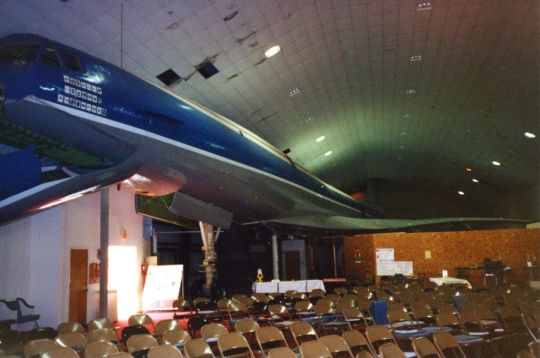
-The 2707 mockup some time in the 1980s. Sunday school classes were held under the port wing for nearly a decade. | Photo: Boeing
In 1990 the remnants of the mockup were sold to Stan Hiller, helicopter pioneer and owner of the Hiller Aviation museum. In 2013 the forward 90' section of the fuselage, now all that remained, were shipped to the Museum of Flight was part of a transfer between the two museums. What's left of the 2707-300 is now under restoration; the last remnants of a grand dream to move air travel forward at Mach 3.

-The remaining segment of the 2707, now 50 years after the program's termination. | Photo: Boeing
#aircraft#aviation#avgeek#airplanes#airplane#cold war#cold war history#coldwar#usaf#aviation history#sst#seattle supersonics#supersonic jet#supersonic transport#supersonic airliner#Boeing#Lockheed#the 60s#the 70s#the sixties#the seventies#faa#air travel#Concorde#boac#air france#Tupolev#tu-144#tu 144#concordeski
95 notes
·
View notes
Link
Everglades Jetport: The 'world's greatest airport' that never was (CNN) — It was supposed to be the world’s largest airport, a glamorous intercontinental hub for supersonic airliners with six runways and high-speed rail links to surrounding cities. But today, it’s little more than an airstrip in the middle of nowhere. The Everglades Jetport, as it was called when the project launched in 1968, started its life right at the end of the Golden Age of air travel, when plane cabins were filled with the smoke of cigars and the clinking of silverware. Concorde was about to make its first flight, while Boeing was working on an even larger and faster supersonic passenger plane, the 2707. With a high projected demand for faster-than-sound travel, South Florida emerged as an ideal spot for a hub, because the dreaded “sonic boom” that made these planes unwelcome guests inland could happen harmlessly over the open ocean. But it wasn’t to be. Commercial aviation was about to enter a different age, and environmental concerns led to the cancellation of the grand plan for the Everglades Jetport after only one runway had been built. Now, that lone runway functions both as a training ground and a nostalgic reminder of a dream that never materialized. Swampland Today, the airport is known as Dade-Collier Training and Transition Airport and is operated by the Miami Dade Aviation Department, which manages four other airports in the area, including Miami International — the third largest in the US for international passenger traffic. It’s very different from what the Everglades Jetport — which was also known as the Big Cypress Swamp Jetport — was meant to be. “Some people think it’s abandoned, but it’s not,” says Lonny Craven, who manages the airfield for the Miami-Dade Aviation Department. “Right now, due to restrictions, we only have it open from eight o’clock in the morning till 5:30 at night.” In the original plan, the Jetport was supposed to be five times the size of New York’s JFK and handle futuristic supersonic airliners carrying up to 300 passengers each. To build it, the Dade County Port Authority purchased 39 square miles of uninhabited swamp land, 36 miles west of the Miami business district and just six miles north of the Everglades National Park. “They wanted to put it smack dab in the middle between Monroe County, Dade County, Collier County and Palm Beach County, for easy access,” says Craven. A planned 1,000-foot-wide road and rail corridor would link the Jetport to both the Atlantic Coast and the Gulf of Mexico. But environmental concerns began to arise soon after construction started. A 1969 report stated that the project would “destroy the South Florida ecosystem and thus the Everglades National Park.” Backed by local residents and activists, the report led to the Everglades Jetport Pact, which in 1970 brought all construction to a halt. “The joke was that they were paving the runways on the backs of alligators,” says Craven. This is a full-scale mockup of the Boeing 2027 SST, pictured in the Boeing Developmental Center in Seattle in 1969. The 2707 was supposed to be America’s answer to the Concorde. AFP/Getty Images Touch and go In 1971, the Boeing 2707 project was canceled before a prototype was even finished, and the dream of a US-built supersonic passenger plane died with it. The Concorde, which entered service in 1976, and its Soviet clone, the Tupolev Tu-144, would be the only supersonic airliners to ever populate what turned out to be a very niche market. At that point, rather than trying to relocate the Jetport, the whole idea was just abandoned. The Tupolev Tu-144 operated from 1968 to 1999. NASA What had been built of the airfield never opened to passenger traffic, but its only runway — which is 10,499 feet long — became popular with pilots in training, who took advantage of the remote location and the absence of any other structure in the area. “It was used a lot through the 1970s, the 1980s, and probably into the mid 1990s, by airlines to go out there and do touch and goes,” says Craven. A “touch and go” happens when a plane lands and takes off again before coming to a complete stop, and it’s a common way for pilots to quickly accumulate practice for these crucial aspects of flying. “With the advent of flight simulators and the high cost of jet fuel, the usage decreased, but we still get practice military flights, mostly from the US Coast Guard, and small private aircraft.” Dade-Collier Training and Transition Airport is what remains of the Jetport dream. Courtesy of Miami-Dade Aviation Department No landings Dade-Collier Training and Transition Airport — whose airport code is the catchy TNT — does not have a terminal, just an office inside a 2,000-square-foot trailer. The site is usually manned by four employees who perform maintenance and also provide security, but there is no firefighting or refueling equipment, and proper landings are not permitted outside of an emergency. “We heard rumors that if the Space Shuttle had to make an emergency landing, it could go there,” says Craven. There have been attempts to use the facility beyond touch and goes. The runway has seen some high-speed car racing, because it allows fast cars to reach their top speeds. And there was a plan to organize an air show, but that would have required widening the road to the airfield to support incoming traffic, and no new construction is permitted. Today, the area surrounding the airport is part of the Big Cypress National Preserve, and home to wildlife such as alligators, deer, herons and bears. The area that the airport also owns, but is undeveloped swamp, is 26,000 acres. That’s how big it could have been. “Miami International Airport is 3,320 acres,” says Craven. “It was supposed to be the airport for tomorrow.” Source link Orbem News #airport #Everglades #greatest #Jetport #worlds
2 notes
·
View notes
Text
'Sân bay vĩ đại nhất thế giới' chưa từng tồn tại

MỹNhiều người tin rằng nếu Tàu con thoi cần hạ cánh khẩn cấp, phi hành đoàn có thể đáp xuống Everglades Jeptport.
Từng được kỳ vọng sân bay lớn nhất thế giới, Everglades Jeptport là một trung tâm đón tiếp các máy bay siêu thanh đến từ mọi lục địa với 6 đường băng cùng đường sắt cao tốc nối với các thành phố xung quanh. Nhưng ngày nay, nó không là gì ngoài một bãi đáp máy bay với một đường băng. Và đường băng đơn độc này tồn tại như lời nhắc nhở về một giấc mơ không bao giờ thành hiện thực của người Mỹ.

Sân bay được kỳ vọng là vĩ đại nhất thế giới chưa bao giờ đón khách. Ảnh: Miami-Dade Aviation Department
Bên cạnh đó, nó cũng thực hiện một chức năng khác, khiêm tốn hơn rất nhiều so với mục đích xây dựng ban đầu: trở thành sân bay chuyển tiếp và đào tạo Dade-Collier thuộc sự quản lý của Cục hàng không Miami Dade. Đây cũng là cơ quan quản lý 4 sân bay khác trong khu vực, gồm Miami - sân bay lớn thứ ba ở Mỹ về lưu lượng hành khách quốc tế.
Sân bay Dade-Collier không có nhà ga, chỉ có một văn phòng nhỏ bên trong một chiếc xe kéo 185m2, với 4 nhân viên. Địa điểm này không cho phép bất kỳ máy bay nào hạ cánh trừ trường hợp khẩn cấp, vì không có bất kỳ thiết bị chữa cháy, tiếp nhiên liệu nào. "Tôi nghe đồn rằng nếu Tàu con thoi phải hạ cánh khẩn thấp, nó có thể tới đây", Lonny Craven, quản lý sân bay nói.
Craven cho biết Everglades Jetport - còn được gọi là Big Cypress Swamp Jetport không hề bị bỏ hoang. "Đó là mọi người nghĩ thế. Hiện tại, do nhiều hạn chế, chúng tôi chỉ mở cửa sân bay từ 8h đến 17h30", anh nói.

Everglades Jetport giờ thuộc sự quản lí của Cục hàng không Miami Dade. Ảnh: Miami-Dade Aviation Department
Dự án xây "sân bay vĩ đại nhất thế giới" Everglades Jetport khởi công từ 1968. Đó cũng là những năm tháng cuối cùng trong thời hoàng kim của du lịch hàng không, khi cabin của những tàu bay tại Mỹ ngập trong khói xì gà và tiếng kêu leng keng của tách, đĩa bạc đựng đồ ăn. Đó cũng là thời điểm Concorde chuẩn bị thực hiện chuyến bay đầu tiên, còn Boeing đang chuẩn bị cho chiếc 2707, máy bay chở khách siêu thanh to lớn và nhanh hơn.
Khi đó, giới chức đã dự đoán nhu cầu du lịch hàng không của người dân ngày càng tăng và cho rằng miền nam Florida là địa điểm lý tưởng để xây dựng một trung tâm hàng không.
Trong kế hoạch xây dựng ban đầu, Everglades Jetport được cho là có kích thước gấp 5 lần sân bay JFK của New York, chuyên đón các máy bay siêu thanh trong tương lai, chở tối đa 300 hành khách. Nó được xây dựng trên mảnh đất không người ở rộng hơn 100 km2, cách Miami 58 km và vườn quốc gia Everglades 10 km. Theo Carven, đây là vị trí trung tâm, nhiều người có thể dễ dàng tiếp cận. Một hành lang đường sắt, đường bộ rộng hơn 300 m được quy hoạch kết nối sân bay tới tận bờ biển Đại Tây Dương, vịnh Mexico.
Nhưng, mọi thứ không đi theo đúng quỹ đạo. Không ai đoán được rằng hàng không thương mại sắp bước vào một thời kỳ khác. Mối lo ngại về vấn đề môi trường bắt đầu xuất hiện, sau khi sân bay khởi công.
Một báo cáo năm 1969 chỉ ra rằng dự án sẽ phá hủy hệ sinh thái của miền nam Florida, và sau đó là vườn quốc gia Everlades. Nhiều người dân địa phương, các nhà hoạt động đã phản đối dự án gay gắt đến mức toàn bộ hoạt động thi công sân bay Everglades Jetport phải dừng vào năm 1970. "Mọi người khi đó đùa rằng họ đang mở một đường băng trên lưng bầy cá sấu", Craven bày tỏ.
Năm 1971, Boeing hủy dự án 2707. Giấc mơ về một chiếc máy bay siêu thanh chở khách do Mỹ chế tạo vì thế cũng "chết" theo.
Khi đó, thay vì cố gắng di dời Everlades Jetport sang một địa điểm khác, chủ đầu tư đã bỏ rơi ý tưởng. Sân bay chưa từng mở cửa cho hành khách, còn đường băng duy nhất của nó dài 3,2km trở thành địa điểm phổ biến với các phi công tập huấn, những người tận dụng vị trí xa xôi, vắng vẻ để bay.

Khoảnh đất bao quanh sân bay là một vùng đầm lầy hoang dã. Ảnh: Miami-Dade Aviation Department
Nơi đây được các hãng bay sử dụng rất nhiều trong những năm 1970, 1980 và đến giữa những năm 1990. Những phi công "hạ cánh và cất cánh ngay" trước khi dừng hẳn, bởi đây là cách phổ biến để nhanh chóng tích lũy kinh nghiệm thực hành cho những bài học quan trọng của quá trình bay.
"Khi những thiết bị mô phỏng chuyến bay ra đời và nhiên liệu tăng giá, các hãng cũng hạn chế cho phi công thực hành. Nhưng chúng tôi vẫn nhận các chuyến bay quân sự tập huấn, chủ yếu của Lực lượng Tuần duyên Mỹ và các máy bay tư nhân nhỏ", Craven tiết lộ.
Ngày nay, khu vực quanh sân bay là một phần của Khu bảo tồn Quốc gia Big Cypress. Nó còn trở thành nơi sinh sống của các loài động vật hoang dã như cá sấu, nai, diệc và gấu.
Khoảnh đất hơn 105 km2 thuộc sở hữu của sân bay vẫn là một đầm lầy chưa được phát triển, Craven đánh giá diện tích này lớn hơn nhiều so với sân bay quốc tế Miami vẻn vẹn hơn 13 km2. "Nó đã được xây để trở thành một sân bay của tương lai", Craven nói về ngày mai không bao giờ đến của Everlades Jetport.
Anh Minh (Theo CNN)
5 quốc gia có nhiều sân bay nhất thế giới
from Tin mới nhất - VnExpress RSS https://ift.tt/3du2QKQ
via IFTTT
0 notes
Photo

Today in Airline History: March 24, 1971. Plans to build the Boeing 2707, what would have been the USA’s first supersonic transport, are cancelled following U.S. Senate and House to deny funding. The plane would have had 250 to 300 seats and cruised at Mach 3.
29 notes
·
View notes
Text

First flight of the Boeing 2707 SST over San Francisco. Pilots to the aircraft over the west coast of the US during the publicized event, starting from the Boeing factory in Seattle, Washington. The flight was known as April Fools.
Date: April 1, 1974
source
#april fool's#april fool's day#Boeing 2707-300#Boeing 2707#2707-300#2707#Supersonic Transport#SST#Supersonic Transport Project#National Supersonic Transport Program#NST#Supersonic Passenger Airliner#Cancelled#April#1974
13 notes
·
View notes
Text
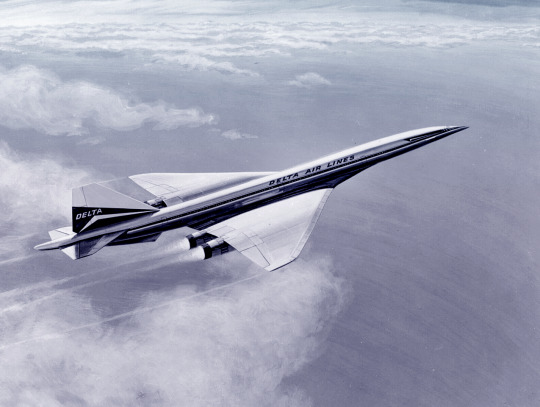
Artist’s concept of the proposed Boeing 2707-300 super sonic transport.
#delta#delta air lines#sst#boeing#boeing sst#super sonic transport#jet airliners#air travel#vintage air travel#the 60s
9 notes
·
View notes
Text
British Airways: How Concorde was actually ‘spelt wrong’ – Thanks to Charles de Gaulle | Travel News | Travel
Concorde was a legendary British turbojet-powered supersonic passenger airliner that was ahead of its time when it was released in 1976. Capable of speeds of Mach 2.04 (1,354mph) with room for 128 passengers, the jet could travel from London to New York in under four hours. Jointly developed and manufactured by Sud Aviation and the British Aircraft Corporation (BAC) under an Anglo-French treaty, 20 planes were built for Air France and British Airways.
While workers were more than happy to co-operate, apparently the story was very different with politicians.
The BBC’s “Concorde: A Supersonic Story” revealed how the workplace was a cheerful place.
Author and historian Jonathan Glancey said in 2017: “Teams of engineers from France and Britain got on very well together, they liked a bit of raillery.
“The French teased the British and the British teased the French so that competition amongst the engineers and the National prides involved led to a very successful machine.”
However, the series went on to reveal how former prime minister Harold Wilson and former French president Charles de Gaulle fell out.
The narrator explained: “But unlike their engineers, the politicians did fall out.
“Harold Wilson was furious with President de Gaulle for adding a letter ‘e’ to the word Concord, so he removed it.
“But de Gaulle put it back and in Bristol and Toulouse the workers didn’t give a flying fig.”
The documentary then showed archived footage of workers back in the Seventies.
One stated: “Some say Concord, some say Concorde, I don’t think it makes any difference at all.”
Another added: “I don’t care what they call it, as long as it’s successful.”
A third even claimed: “I think we may as well be together and put an ‘e’ on and get on with it.”
It was also revealed during the same series how the unveiling of Concorde “infuriated” former US President John F. Kennedy.
The narrator detailed: “A year on from the Anglo-French treaty, the first designs of Concorde were released.
“A wooden mock-up demonstrated the interior and high-tech windshield.
“Airlines across the world responded with great excitement, 16 airlines ordered some 75 aircraft, many of the orders were by airlines in the US, which infuriated President John F. Kennedy.
“So he announced a plane that would be bigger, faster and travel even further than Concorde.”
Immediately in a statement to the public, JFK announced plans for the Boeing 2707.
The design emerged as a large aircraft with seating for 250 to 300 passengers and cruise speeds of approximately 2,300mph.
It was intended to be much larger and faster than proceeding designs such as Concorde.
President Kennedy said in his announcement: “My judgement is that this government should immediately commence a new programme in partnership with private industry to develop at the earliest practical date the prototype of a commercially successful supersonic transport superior to that being built in any other county in the world.
“If we can build the best operational plane of this type – and I believe we can – then Congress and the country should be prepared to invest the funds and effort necessary to maintain this nation’s lead in long-range aircraft – a lead we have held since World War 2.
“Spurred [on] by competition from across the Atlantic and by the production of our own companies, the Federal Government must pledge funds to supplement the risk capital to be contributed by private companies
“We are talking about a plane, at the end of the Sixties that will move ahead at a speed greater than Mach 2 to all four corners of the globe.”
The post British Airways: How Concorde was actually ‘spelt wrong’ – Thanks to Charles de Gaulle | Travel News | Travel appeared first on Tripstations.
from Tripstations http://bit.ly/2Y3Srv9
via IFTTT
0 notes
Text
美利坚的超音速客机梦-波音2707
曾经偶然在网上看到过一组超音速客机的CG作品,当是觉得与协和和Tu-144即像又不像,或者说我更喜欢这架未知客机的可变后掠翼造型,后来才知道它是未能投入生产的波音2707型超音速客机,也是迄今为止美国唯一政府主导出资的民航客机项目。
2707项目背景
自耶格尔突破音速以后,人们对于超音速了解的越来越多,50年代开始超音速战斗机陆续服役(F-100和米格21)。在民航领域,自1949年英国哈维兰彗星喷气式客机服役后,人们对于大型客机速度的追求并未停止,随着技术的进步,使得客机进行超音速飞行变得不再遥不可及。在诸多因素的驱动下,欧洲的英法苏和大西洋彼岸的美国,陆续研发了自己的超音速客机。
项目代号733



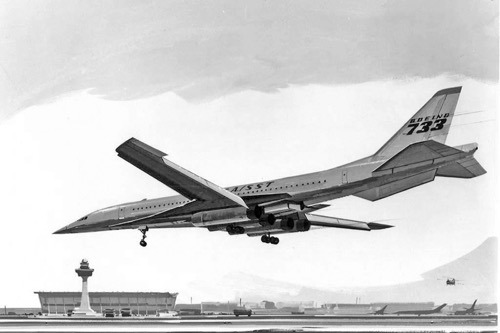
官方的正式名称是正式官方名称为波音733-197,但这个名称相对陌生,最熟悉的是另一个名称2707,此外1966年获得了该项目,所以还有个1966型的名称
获得胜利
波音和竞争者洛克希德在1966年9月提交了全尺寸模型,1966年12月31日美国联邦航空局宣布波音获胜,洛克希德的L-2000虽然拥有研制风险低和更易生产的优势。但因为FAA希望生产一架性能先进的客机,导致性能略低的洛克希德L-2000输掉了这场竞争。
研发型号
从波音在1966年底获得项目到1971年终止拨款为止,五年间,2707项目一共研发了三个型号。主要特征就是100型是可变后掠翼,200型添加鸭翼,300型回归固定三角翼。
Boeing 2707-100型

2707-100型与Tu-144和协和最大的不同是采用了可变后掠翼设计而非固定三角翼。在随后波音提交的方案上又把可变后掠翼的最小角度从30度降低到20度,以获得更好的起降性能,并且得以扩大机身宽度,使得座位布置从3-3变成2-3-2(Tu-144是2-3,协和是2-2),从这些机体变化可以看出2707的体积比它的竞争对手大不少。同时为了改善机组人员的视线,boeing 2707也采用了可下垂式头锥。2707的超音速巡航升阻比是8.2,高于协和式的7,与Tu-144D接近。
做为当时技术最先进的超音速客机,获得项目胜利的2707-100型可搭载277名乘客(30名头等舱客人和247普通客人),它的对手Tu-144通常只能载70~80人,协和多一些有100人。2707-100的时速也是三者中最快的,只有航程大家都差不多。
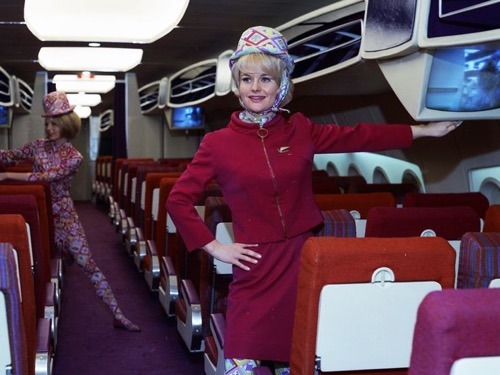
此外在当时的超音速客机里,2707是唯一带有娱乐系统的,头等舱和经济舱都有

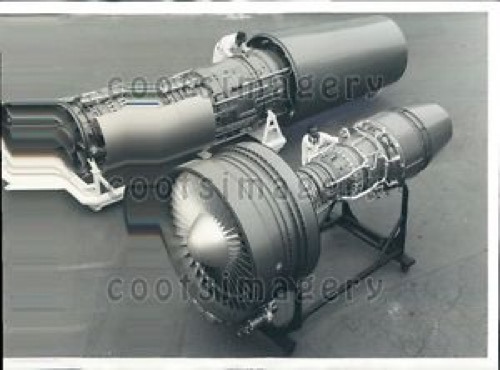
Boeing 2707有70%的时间都是在超音速飞行,环境恶劣,因此对发动机的安全性、可靠性、可维护性都大大超过以前的发动机。必须使用最先进的技术来打造
2707项目动力:通用电气的GE4涡喷发动机,设计于2016世纪60年代末,作为波音2707超音速客机的发动机。GE4是轴流式涡喷发动机,以YJ93为基础研发,YJ93本是XB-70轰炸机的发动机。随着2707项目的下马,GE4也结束了研制。
对于2707-100型的研发一开始波音的预计是乐观的,1967年建造原型机,1970年进行首次试飞,生产可以在1969年开始,1972年进行飞行测试,1974年年中获得适航证
Boeing 2707-200型

再研发100型时波音公司对于可变后掠翼结构超重问题束手无策,使得飞机在的稳定性和承载能力成为了重点解决的问题,导致2707第二次重大修改,2707-200型诞生,200型相对100型,在机身前部增加了一对儿鸭翼(不同于Tu-144的是这对鸭翼没法折叠)。但随着时间的推移,可变后掠翼及其配套系统的超重问题仍像梦魔缠绕着2707项目。
1968年1月15日,FAA技术团队审查了波音公司的设计,发现因为增重的原因,200型满载航程只有2775英里。“失望的联邦航空局曾说空载的2707可以飞越大西洋,但满载的只能飞到大西洋中部。”1968年3月29日联邦航空局要求波音公司提交一架满足第三阶段合同标准的原型机,这促使波音大幅修改了原来的设计,2707最后一个型号300型诞生。
Boeing 2707-300

尽管可变后掠翼有诸多优点,但因为发动机布局引起的机翼结构加强,导致了结构增重,有效载荷的减少问题始终无法解决,促使波音公司在1968年10月21日宣布在300型上抛弃了可变后掠翼设计,变成了固定三角翼设计,载客量也减低至234人。为增强300型的稳定性,机身缩短了150英尺,重量减轻了6000磅,航程增加了225海里。但减重是以飞行和航电系统的成本增加为代价,比波音747增加了2倍。1969年1月,FAA也批准了波音的新设计。1969年6月9日,在晚于计划两年后,波音制造了一架全尺寸模型。不过两年后因为各种因素的影响,国会投票终止了拨款,Boeing 2707项目下马。
2707项目遇到的问题
气动加热
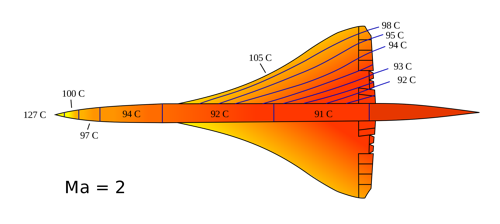
如果客机使用铝合金制造,那么速度只能到2.5马赫,再提高就需要使用耐热材料了。为此协和式和Tu-144的巡航速度都被限制在2马赫。不过美国有研制3马赫轰炸机XB-70的经验,在Boeing 2707上使用了不锈钢,使得该机的巡航速度达到了2.7马赫
音爆
音爆问题是导致2707项目下马的关键原因之一,为了调查音爆对于公众的影响,1968年FAA-美国空军在俄克拉荷马城联合展开了音爆试验,每天F-104战斗机在城市上定时产生8次音爆,很多人把这些音爆当作了闹钟来用(昂贵的闹钟)
有的人听到第一次音爆就会起床,因为这时候是早上七点了,然后去洗澡,听到第二声音爆把水关上,因为这时候正好是七点二十。工人会把十一点的音爆当成休息的信号
上面这些事只是音爆试验带来的小插曲,1965年4月25日FAA公布了音爆试验的结构,总共在城市上空产生1253次音爆,大部分的音爆都在能承受范围呢。这场持续了六个月的试验,在前三个月的时间内,百分之九十的人认为可以忍受,到了六个月后这个数字降低到了百分之七十三。在测试的最后几周,有百分之二十七的人再也无法忍受音爆,百分之四十的人不相信音爆不会对建筑物造成损坏。
这些公众的反应对FAA是坏消息。随后B-58轰炸机从洛杉矶飞往纽约的两小时航程进行了音爆测试,反应是灾难性的,从西海岸到东海岸,公众惊慌的拨打警察局的电话,描述他们听到一声可怕的爆炸声(音爆)
FAA在新墨西哥州的白沙试验场、空军在爱德华兹空军基地进行了2磅到20磅的超压试验,两项测试显示5磅以下的音爆不会对结构合理的建筑产生影响。但对于老旧建筑/玻璃的裂纹会产生潜在的风险,对公众的健康也会造成不可预测的结果
对于这些讨厌的音爆也有一些专家发布意见,一旦欧洲和美国的超音速客机都投入到运营后,美国会有6500万人,每天遭受到10次音爆的袭击。凡此种种的经历后,波音公司和FAA决定超音速客机只能把超音速飞行限定在海上(后来协和式客机也是这样)。
为了解决超音速客机的音爆问题,NASA和康奈尔大学在上世纪70年代进行了减少音爆的研究,技术成熟后,在2003年NASA和相关机构在一架F-5战斗机上实验减少音爆成功,这有助于减少音爆对于公众的困扰,为超音速客机在陆地上进行超音速飞行铺平道路。
臭氧
下面超音速客机还要面临着环境污染问题,这些客机普遍飞的高度比亚音速客机要高出许多,它们排放的废气极有可能使得存在于平流层的臭氧层变薄。特雷恩指出,平流层本身很干燥,但是当大批的超音速客机出现在这里,它们会带来大量的水蒸气、二氧化碳、氮氧化物和其他颗粒物质,这些物质会严重破坏臭氧层,给公众健康带来危险。此类影响环境的言论在当时非常的多。对这些言论抱有批评的也不少,但更多的还是对超音速客机持有疑虑。随后气候影响评估项目建立,结论大抵是如果大批量超音速客机服役,就必须改进推进技术,以确保排放物不会破坏平流层中的臭氧层。国会也支持NASA研发低排放喷气发动机技术。
依据以上事件和其他各项研究,1975年,气象组织召集一批专家编写了关于臭氧层的权威声明,标志着人类第一次关于臭氧大量减少带来的危害的国际性警告,并建议全球为此展开行动
宇宙射线
对于机组人员和乘客暴露在太阳高能粒子下也引起了人们的担忧。地球在每个纬度的辐射剂量都是不一样的,譬如在迟到80000英尺处的辐射强度是低于60000英尺的。现代商业航班使得机组人员成为暴露在辐射下的群体,而超音速客机又比亚音速客机飞行在更高的高度,会暴露在更多的宇宙射线下。
协和式客机在飞机上装有宇宙射线测量仪和量度辐射减低率的仪器,一旦检测到辐射量过高,就会立即降低高度。想来如果波音2707投入服役也会安装类似的仪器。
竞争者

协和式和Tu-144的性能没有Boeing 2707那么强大,只有在服役这件事上比它强
Tu-144
苏联的Tu-144赢得了超音速客机竞赛的胜利,原型机于1968年12月31日在莫斯科附近首飞,1969年6月5日突破音障,1973年6月3日巴黎航展上发生坠毁事故。1975年12月26日苏联开通世界上第一条超音速客机航班服务,从莫斯科到阿拉木图。1978年5月23日发生空难,随后6月Tu-144退出客运,非正式航线最后一班到1987年
协和式
相比匆匆投入客货运市场的Tu-144,它的竞争对手协和式显得更加成功。首飞比Tu-144晚了一年,投入客运市场也晚了一年,但在正式航线的客运服役却比Tu-144长了25年。
0 notes
Photo

Model of proposed SST, in office of FAA Commissioner, Gordon M. Bain. The Boeing 2707 was the first American supersonic transport (SST) project. After winning a competition for a government-funded contract to build an American SST, Boeing began development at its facilities in Seattle, Washington. The design emerged as a large aircraft with seating for 250 to 300 passengers and cruise speeds of approximately Mach 3. It would have been much larger and faster than preceding SST designs such as Concorde. It never went ahead (despite more orders and interest than the Concorde). . #history #aviationhistory #boeing #boeing2707 #crewlife #faa #concorde http://fat.ly/3ssrh
[ Instagram ]
0 notes
Text

Concept art of a Boeing SST taking off.
Date: February 17, 1993
Mike Acs's Collection: link
source
#Boeing 2707-300#Boeing 2707#2707-300#2707#Supersonic Transport#SST#Supersonic Passenger Airliner#Cancelled#concept art#1971#undated#my post
18 notes
·
View notes